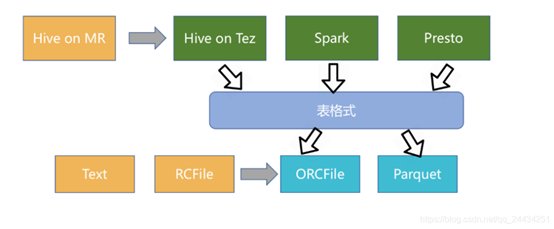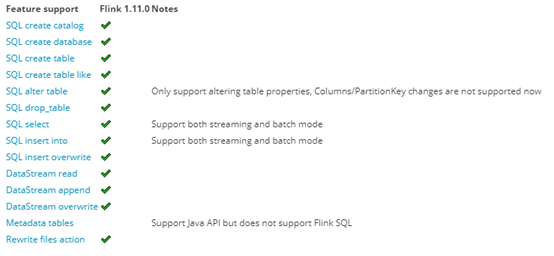1. 概述
Apache Iceberg is an open table format for huge analytic datasets. Iceberg adds tables to Presto and Spark that use a high-performance format that works just like a SQL table.
官方的定义,iceberg是一种表格式。我们可以简单理解为他是基于计算层(flink、spark)和存储层(orc、parqurt)的一个中间层,我们可以把它定义成一种“数据组织格式”,Iceberg将其称之为“表格式”也是表达类似的含义。他与底层的存储格式(比如ORC、Parquet之类的列式存储格式)最大的区别是,它并不定义数据存储方式,而是定义了数据、元数据的组织方式,向上提供统一的“表”的语义。它构建在数据存储格式之上,其底层的数据存储仍然使用Parquet、ORC等进行存储。在hive建立一个iceberg格式的表。用flink或者spark写入iceberg,然后再通过其他方式来读取这个表,比如spark、flink、presto等。

Iceberg的架构和实现并未绑定于某一特定引擎,它实现了通用的数据组织格式,利用此格式可以方便地与不同引擎(如Flink、Hive、Spark)对接。
2. Iceberg优势
- 增量读取处理能力:Iceberg支持通过流式方式读取增量数据,支持Structed Streaming以及Flink table Source;
- 支持事务(ACID),上游数据写入即可见,不影响当前数据处理任务,简化ETL;提供upsert和merge into能力,可以极大地缩小数据入库延迟;
- 可扩展的元数据,快照隔离以及对于文件列表的所有修改都是原子操作;
- 同时支持流批处理、支持多种存储格式和灵活的文件组织:提供了基于流式的增量计算模型和基于批处理的全量表计算模型。批处理和流任务可以使用相同的存储模型,数据不再孤立;Iceberg支持隐藏分区和分区进化,方便业务进行数据分区策略更新。支持Parquet、Avro以及ORC等存储格式。
- 支持多种计算引擎,优秀的内核抽象使之不绑定特定的计算引擎,目前Iceberg支持的计算引擎有Spark、Flink、Presto以及Hive。
3. Flink+ Iceberg搭建使用
Apache Iceberg支持Apache Flink的DataStream Api和Table Api写记录进iceberg表。当前,我们只集成Iceberg和apache flink 1.11.x。

3.1. 准备
为了在flink中创建iceberg表,我们要求使用flink SQL client,因为这对使用者们来说更容易去理解概念。
准备两个jar包:
- 从apache官方仓库下载flink-runtime.jar,
- flink的hive connector jar包,
启动flink sql client,不带hive connector jar包,可以创建hadoop catalog如下:
./bin/sql-client.sh embedded \ -j /data/flink-1.11.2/lib/iceberg-flink-runtime-0.10.0.jar \ shell
启动flink sql client,带hive connector jar包,可以创建hadoop catalog和hive catalog如下:
./bin/sql-client.sh embedded \ -j /data/flink-1.11.2/lib/iceberg-flink-runtime-0.10.0.jar \ -j /data/flink-1.11.2/lib/flink-sql-connector-hive-2.2.0_2.11-1.11.2.jar \ shell
3.2. 创建catalogs和使用catalogs
Flink1.11支持通过flink sql创建catalogs
3.2.1 Hive catalog
创建一个名为hive_catalog的 iceberg catalog ,用来从 hive metastore 中加载表。
CREATE CATALOG hive_catalog WITH ( 'type'='iceberg', 'catalog-type'='hive', 'uri'='thrift://localhost:9083', 'clients'='5', 'property-version'='1', 'warehouse'='hdfs://nn:8020/warehouse/path');
- type: 只能使用iceberg,用于 iceberg 表格式。(必须)
- catalog-type: Iceberg 当前支持hive或hadoopcatalog 类型。(必须)
- uri: Hive metastore 的 thrift URI。 (必须)
- clients: Hive metastore 客户端池大小,默认值为 2。 (可选)
- property-version: 版本号来描述属性版本。此属性可用于在属性格式发生更改时进行向后兼容。当前的属性版本是 1。(可选)
- warehouse: Hive 仓库位置, 如果既不将 hive-conf-dir 设置为指定包含 hive-site.xml 配置文件的位置,也不将正确的 hive-site.xml 添加到类路径,则用户应指定此路径。
- hive-conf-dir: 包含 Hive-site.xml 配置文件的目录的路径,该配置文件将用于提供自定义的 Hive 配置值。 如果在创建 iceberg catalog 时同时设置 hive-conf-dir 和 warehouse,那么将使用 warehouse 值覆盖 < hive-conf-dir >/hive-site.xml (或者 classpath 中的 hive 配置文件)中的 hive.metastore.warehouse.dir 的值。
3.2.2 Hadoop catalog
Iceberg 还支持 HDFS 中基于目录的 catalog ,可以使用’catalog-type’='hadoop’进行配置:
CREATE CATALOG hadoop_catalog WITH ( 'type'='iceberg', 'catalog-type'='hadoop', 'warehouse'='hdfs://nn:8020/warehouse/path', 'property-version'='1');
- warehouse:hdfs目录存储元数据文件和数据文件。(必须)
我们可以执行sql命令USE CATALOG hive_catalog来设置当前的catalog。
3.2.3 Custom catalog
Flink也支持通过指定catalog-impl属性来加载自定义的Iceberg catalog接口。当catalog-impl设置了,catalog-type的值可以忽略,这里有个例子:
CREATE CATALOG my_catalog WITH ( 'type'='iceberg', 'catalog-impl'='com.my.custom.CatalogImpl', 'my-additional-catalog-config'='my-value');
3.2.4 Create through YAML config
在启动SQL客户端之前,Catalogs可以通过在sql-client-defaults.yaml文件中注册。这里有个例子:
catalogs: - name: my_catalog type: iceberg catalog-type: hadoop warehouse: hdfs://nn:8020/warehouse/path
3.3. DDL命令
- 创建数据库
默认的,iceberg将会在flink中使用default数据库。如果我们不想在default数据库下面创建表,可以使用下面的例子去创建别的数据库。
CREATE DATABASE iceberg_db;USE iceberg_db;
- 创建表
CREATE TABLE hive_catalog.default.sample ( id BIGINT COMMENT 'unique id', data STRING);
表创建命令支持最常用的 flink create 子句,包括:
PARTITION BY (column1, column2, ...) 配置分区,apache flik 还不支持隐藏分区。
COMMENT 'table document'设置一个表描述。
WITH ('key'='value', ...)设置将存储在 apache iceberg 表属性中的表配置。
目前,它不支持计算列、主键和水印定义等。
- PARTITIONED BY 分区
要创建分区表,使用 PARTITIONED BY:
CREATE TABLE hive_catalog.default.sample ( id BIGINT COMMENT 'unique id', data STRING) PARTITIONED BY (data);
Apache Iceberg支持隐藏分区但apache flink不支持在列上按照函数分区,因此我们现在没有途径在flink DDL上支持隐藏分区,我们在未来将会改善flink DDL。
- CREATE TABLE LIKE
为了创建和另一张表具有相同结构、分区和表属性的一张表,使用CREATE TAABLE LIKE。
CREATE TABLE hive_catalog.default.sample ( id BIGINT COMMENT 'unique id', data STRING);CREATE TABLE hive_catalog.default.sample_like LIKE hive_catalog.default.sample;
为了更详细,可以查看。
- ALTER TABLE 更改表
Iceberg 现在只支持在 flink 1.11中修改表属性。
ALTER TABLE hive_catalog.default.sample SET ('write.format.default'='avro') - ALTER TABLE .. RENAME TO
ALTER TABLE hive_catalog.default.sample RENAME TO hive_catalog.default.new_sample;
- DROP TABLE 删除表
DROP TABLE hive_catalog.default.sample;
3.4. sql读写
3.4.1. Sql查询
Iceberg现在支持flink流式读和批量读。我们可以执行下面sql命令去把执行类型流式模式切换为批处理模式,如下:
-- Execute the flink job in streaming mode for current session contextSET execution.type = streaming-- Execute the flink job in batch mode for current session contextSET execution.type = batch
3.4.1.1. Flink批量读
如果在提交flink批处理作业时想要检查iceberg表中所有的记录,你可以执行下面的句子:
-- Execute the flink job in streaming mode for current session contextSET execution.type = batch ;SELECT * FROM sample;
3.4.1.2. Flink流式读
Iceberg支持处理flink流式作业中的增量数据,该数据从历史快照ID开始:
-- Submit the flink job in streaming mode for current session.SET execution.type = streaming ;-- Enable this switch because streaming read SQL will provide few job options in flink SQL hint options.SET table.dynamic-table-options.enabled=true;-- Read all the records from the iceberg current snapshot, and then read incremental data starting from that snapshot.SELECT * FROM sample /*+ OPTIONS('streaming'='true', 'monitor-interval'='1s')*/ ;-- Read all incremental data starting from the snapshot-id '3821550127947089987' (records from this snapshot will be excluded).SELECT * FROM sample /*+ OPTIONS('streaming'='true', 'monitor-interval'='1s', 'start-snapshot-id'='3821550127947089987')*/ ; 这些是可以在flink SQL提示选项中为流作业设置的选项:
- monitor-interval:连续监视新提交的数据文件的时间间隔(默认值:1s)
- start-snapshot-id:流式作业开始的快照id
3.4.2. Sql写入
现在Iceberg支持在flink1.11中使用insert into和insert overwrite。
- INSERT INTO
flink 流作业将新数据追加到表中,使用 INSERT INTO:
INSERT INTO hive_catalog.default.sample VALUES (1, 'a');INSERT INTO hive_catalog.default.sample SELECT id, data from other_kafka_table;
- INSERT OVERWRITE
要使用查询结果替换表中的数据,请在批作业中使用 INSERT OVERWRITE (flink 流作业不支持 INSERT OVERWRITE)。覆盖是 Iceberg 表的原子操作。
具有由 SELECT 查询生成的行的分区将被替换,例如:
INSERT OVERWRITE sample VALUES (1, 'a');
Iceberg 还支持通过 select 值覆盖给定的分区:
INSERT OVERWRITE hive_catalog.default.sample PARTITION(data='a') SELECT 6;
对于分区的Iceberg表,当在PARTITION子句中为所有分区设置值时,它将插入到静态分区中;否则,如果在PARTITON子句中将部分分区列(所有分区列的前缀部分)设置为值,则将查询结果写入动态分区。对于未分区的Iceberg表,其数据将被INSERT OVERWRITE完全覆盖。
3.5. DataStream读写数据(Java API)
3.5.1. DataStream读数据
Iceberg现在支持使用Java API流式或者批量读取。
3.5.1.1. 批量读
这个例子从Iceberg表读取所有记录,然后在flink批处理作业中打印到stdout控制台。
StreamExecutionEnvironment env = StreamExecutionEnvironment.createLocalEnvironment();TableLoader tableLoader = TableLoader.fromHadooptable("hdfs://nn:8020/warehouse/path");DataStream batch = FlinkSource.forRowData() .env(env) .tableLoader(loader) .streaming(false) .build();// Print all records to stdout.batch.print();// Submit and execute this batch read job.env.execute("Test Iceberg Batch Read"); 3.5.1.2. 流式读
这个例子将会读取从快照id‘3821550127947089987’开始的增量记录,然后在flink流式作业中打印到stdout控制台中。
StreamExecutionEnvironment env = StreamExecutionEnvironment.createLocalEnvironment();TableLoader tableLoader = TableLoader.fromHadooptable("hdfs://nn:8020/warehouse/path");DataStream stream = FlinkSource.forRowData() .env(env) .tableLoader(loader) .streaming(true) .startSnapshotId(3821550127947089987) .build();// Print all records to stdout.stream.print();// Submit and execute this streaming read job.env.execute("Test Iceberg streaming Read"); 还有其他选项可以通过Java Api设置,详情请看.
3.5.2. DataStream写数据
Iceberg 支持从不同的 DataStream 输入写入 Iceberg 表。
- Appending data 追加数据
我们支持在本地编写 DataStream < rowdata > 和 DataStream < Row> 到 sink iceberg 表。
StreamExecutionEnvironment env = ...;DataStreaminput = ... ;Configuration hadoopConf = new Configuration();TableLoader tableLoader = TableLoader.fromHadooptable("hdfs://nn:8020/warehouse/path");FlinkSink.forRowData(input) .tableLoader(tableLoader) .hadoopConf(hadoopConf) .build();env.execute("Test Iceberg DataStream");
- Overwrite data 重写数据
为了动态覆盖现有 Iceberg 表中的数据,我们可以在FlinkSink构建器中设置overwrite标志。
StreamExecutionEnvironment env = ...;DataStreaminput = ... ;Configuration hadoopConf = new Configuration();TableLoader tableLoader = TableLoader.fromHadooptable("hdfs://nn:8020/warehouse/path");FlinkSink.forRowData(input) .tableLoader(tableLoader) .overwrite(true) .hadoopConf(hadoopConf) .build();env.execute("Test Iceberg DataStream");
3.6. 检查表
现在Iceberg不支持在flink Sql中检查表,我们需要使用 去读取Iceberg来得到这些表信息。
3.7. 重写文件操作
Iceberg可以通过提交flink批作业去提供API重写小文件变为大文件。flink操作表现与spark的.一样。
import org.apache.iceberg.flink.actions.Actions;TableLoader tableLoader = TableLoader.fromHadooptable("hdfs://nn:8020/warehouse/path");Table table = tableLoader.loadTable();RewriteDataFilesActionResult result = Actions.forTable(table) .rewriteDataFiles() .execute(); 更多的重写文件操作选项文档,请看
3.8. 将来提升
当前flink iceberg整合工作还有下面的特性不支持:
- 不支持创建带有隐藏分区的Iceberg表;
- 不支持创建带有计算列的Iceberg表;
- 不支持创建带有水印的Iceberg表;
- 不支持添加列,删除列,重命名列,修改列;
4. Iceberg实例
4.1. 使用编程SQL方式读写Iceberg表
4.1.1. 添加依赖
org.apache.iceberg iceberg-flink-runtime 0.10.0
4.1.2. 部分代码实现
// 使用table api 创建 hadoop catalog TableResult tableResult = tenv.executeSql("CREATE CATALOG hadoop_catalog WITH (\n" + " 'type'='iceberg',\n" + " 'catalog-type'='hadoop',\n" + " 'warehouse'='hdfs://nameservice1/tmp',\n" + " 'property-version'='1'\n" + ")"); // 使用catalog tenv.useCatalog("hadoop_catalog"); // 创建库 tenv.executeSql("CREATE DATABASE if not exists iceberg_hadoop_db"); tenv.useDatabase("iceberg_hadoop_db"); // 创建iceberg 结果表 tenv.executeSql("drop table hadoop_catalog.iceberg_hadoop_db.iceberg_001"); tenv.executeSql("CREATE TABLE hadoop_catalog.iceberg_hadoop_db.iceberg_001 (\n" + " id BIGINT COMMENT 'unique id',\n" + " data STRING\n" + ")"); // 测试写入 tenv.executeSql("insert into hadoop_catalog.iceberg_hadoop_db.iceberg_001 select 100,'abc'"); 4.1.3. 创建hive的外部表来实时查询iceberg表
hive> add jar /tmp/iceberg-hive-runtime-0.10.0.jar; hive> CREATE EXTERNAL TABLE tmp.iceberg_001(id bigint,data string)STORED BY 'org.apache.iceberg.mr.hive.HiveIcebergStorageHandler' LOCATION '/tmp/iceberg_hadoop_db/iceberg_001'; hive> select * from tmp.iceberg_001;OK100 abc1001 abcdTime taken: 0.535 seconds, Fetched: 2 row(s)
4.2. Flink结合Kafka实时写入Iceberg实践笔记
4.2.1. 创建Hadoop Catalog的Iceberg 表
// create hadoop catalog tenv.executeSql("CREATE CATALOG hadoop_catalog WITH (\n" + " 'type'='iceberg',\n" + " 'catalog-type'='hadoop',\n" + " 'warehouse'='hdfs://nameservice1/tmp',\n" + " 'property-version'='1'\n" + ")"); // change catalog tenv.useCatalog("hadoop_catalog"); tenv.executeSql("CREATE DATABASE if not exists iceberg_hadoop_db"); tenv.useDatabase("iceberg_hadoop_db"); // create iceberg result table tenv.executeSql("drop table hadoop_catalog.iceberg_hadoop_db.iceberg_002"); tenv.executeSql("CREATE TABLE hadoop_catalog.iceberg_hadoop_db.iceberg_002 (\n" + " user_id STRING COMMENT 'user_id',\n" + " order_amount DOUBLE COMMENT 'order_amount',\n" + " log_ts STRING\n" + ")"); 4.2.2. 使用Hive Catalog创建Kafka流表
String HIVE_CATALOG = "myhive"; String DEFAULT_DATABASE = "tmp"; String HIVE_CONF_DIR = "/xx/resources"; Catalog catalog = new HiveCatalog(HIVE_CATALOG, DEFAULT_DATABASE, HIVE_CONF_DIR); tenv.registerCatalog(HIVE_CATALOG, catalog); tenv.useCatalog("myhive"); // create kafka stream table tenv.executeSql("DROP TABLE IF EXISTS ods_k_2_iceberg"); tenv.executeSql( "CREATE TABLE ods_k_2_iceberg (\n" + " user_id STRING,\n" + " order_amount DOUBLE,\n" + " log_ts TIMESTAMP(3),\n" + " WATERMARK FOR log_ts AS log_ts - INTERVAL '5' SECOND\n" + ") WITH (\n" + " 'connector'='kafka',\n" + " 'topic'='t_kafka_03',\n" + " 'scan.startup.mode'='latest-offset',\n" + " 'properties.bootstrap.servers'='xx:9092',\n" + " 'properties.group.id' = 'testGroup_01',\n" + " 'format'='json'\n" + ")"); 4.2.3. 使用SQL连接kafka流表和iceberg 目标表
System.out.println("---> 3. insert into iceberg table from kafka stream table .... "); tenv.executeSql( "INSERT INTO hadoop_catalog.iceberg_hadoop_db.iceberg_002 " + " SELECT user_id, order_amount, DATE_FORMAT(log_ts, 'yyyy-MM-dd') FROM myhive.tmp.ods_k_2_iceberg"); 4.2.4. 数据验证
bin/kafka-console-producer.sh --broker-list xx:9092 --topic t_kafka_03{ "user_id":"a1111","order_amount":11.0,"log_ts":"2020-06-29 12:12:12"}{ "user_id":"a1111","order_amount":11.0,"log_ts":"2020-06-29 12:15:00"}{ "user_id":"a1111","order_amount":11.0,"log_ts":"2020-06-29 12:20:00"}{ "user_id":"a1111","order_amount":11.0,"log_ts":"2020-06-29 12:30:00"}{ "user_id":"a1111","order_amount":13.0,"log_ts":"2020-06-29 12:32:00"}{ "user_id":"a1112","order_amount":15.0,"log_ts":"2020-11-26 12:12:12"} hive> add jar /home/zmbigdata/iceberg-hive-runtime-0.10.0.jar;hive> CREATE EXTERNAL TABLE tmp.iceberg_002(user_id STRING,order_amount DOUBLE,log_ts STRING)STORED BY 'org.apache.iceberg.mr.hive.HiveIcebergStorageHandler' LOCATION '/tmp/iceberg_hadoop_db/iceberg_002';hive> select * from tmp.iceberg_002 limit 5;a1111 11.0 2020-06-29a1111 11.0 2020-06-29a1111 11.0 2020-06-29a1111 11.0 2020-06-29a1111 13.0 2020-06-29Time taken: 0.108 seconds, Fetched: 5 row(s) 参考资料:
https://blog.csdn.net/u010834071/article/details/112507474 Flink结合Iceberg的一种实现方式笔记
https://zhengqiang.blog.csdn.net/article/details/112850376 Flink结合Kafka实时写入Iceberg实践笔记